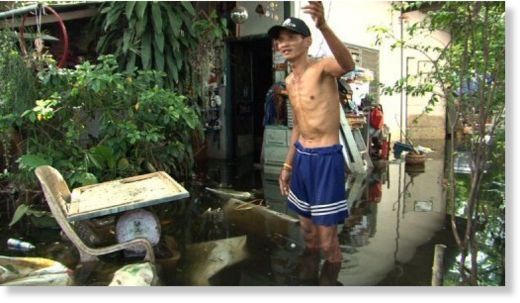
The government said the disaster has now killed 506 people nationwide -- an increase of 60 from the figure reported a day earlier. So far no deaths in Bangkok have been reported in the official toll.
At least 20 percent of the capital is already submerged in floodwater contaminated by rubbish, dead animals and industrial waste, raising fears about outbreaks of disease in the densely populated metropolis of 12 million people.
The slow-moving water is now just a few kilometres (miles) away from business and tourist districts, and authorities are desperately seeking to push the floods through waterways in the east and west of the city and out to sea.
Amid mounting concern over the advancing waters, Prime Minister Yingluck Shinawatra on Saturday said Bangkok's economic and political heartland risked only "minor and brief" flooding at most.
"If all measures are implemented as planned we can save the economic zone of Bangkok," she said in a weekly radio and television address to the nation.
She added that a six-kilometre (four-mile) flood wall of huge sandbags had been erected in northern Bangkok and more water pumps had been installed in other parts of the city to keep the downtown area dry.
The floodwaters have already swamped the busy Lat Phrao intersection on the northern edge of the city centre, forcing the closure of the Central Plaza shopping mall and of several nearby roads, including sections of main traffic arteries.
Nearby Chatuchak weekend market -- a popular tourist attraction -- was open for business on Sunday but many traders stayed away after warnings from officials to be on alert for possible inundations.
Authorities are also closely watching several at-risk underground rail stations that might have to be shut down if the water level rises in the area, although the service was operating normally on Sunday.
The floods, triggered by unusually heavy monsoon rains that began three months ago, have damaged the homes and livelihoods of millions across the kingdom.
In Bangkok, more than a million people have been told to evacuate 10 districts out of a total of 50 in the capital, and a partial evacuation order has been issued in five others.
But many have chosen to stay in their homes despite risks including electrocution, disease and lack of food and drinking water, complicating relief efforts.
Worst-hit residents have complained that their neighbourhoods are being sacrificed to save downtown Bangkok's shopping malls, luxury hotels and the houses of the wealthy elite, triggering protests and the destruction of some flood barriers.
The waters have also swamped Bangkok's number two airport Don Mueang, which usually serves mostly domestic destinations, but the kingdom's main air gateway Suvarnabhumi east of the city centre is operating as usual.
Thai authorities failed to save a number of major industrial parks from the floods, despite earlier assurances they would be protected.
The crisis is taking its toll on the lucrative Thai tourism industry, with countries including the United States, Britain, Singapore, Canada and the Netherlands advising against all but essential travel to Bangkok.



Reader Comments
to our Newsletter